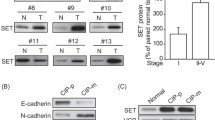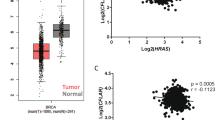Abstract
Tumor formation can result from a decrease in cell death, as well as an increase in cell proliferation. In spite of the high incidence of mammary gland tumors (MGTs) in female dogs, the understanding of its etiology is still poor. Consistent with several proto-oncogenes (such as Wnt) for the mammary gland, sFRP2 is expressed in canine MGTs which is normally silent in the mammary gland. To elucidate the roles of SFRP2 in the tumorigenesis of MGTs, apoptosis regulation mediated by sFRP2 was investigated by overexpression of sFRP2 in MGT cells. DNA fragmentation and TUNEL assays showed a decreased susceptibility of the cells to UV-induced apoptosis in the context of sFRP2 overexpression. To analyze the pathways through which sFRP2 transduces anti-apoptosis signals, multiple-color immunofluorescence staining, immunoprecipitation, and immunoblotting were carried out. sFRP2 was found co-localized in the extracellular matrix of MGTs and the tyrosine phosphorylation of FAK was enhanced. Moreover, JNK was suppressed and NF-kB was activated in the cells expressing sFRP2 after UV-induced apoptosis analyzed by immunoblotting and electrophoretic mobility shift assay (EMSA). Taken together, these results suggest that sFRP2 exerts its anti-apoptotic function in mammary cancer cells through NF-κB activation or JNK suppression.
Similar content being viewed by others
References
Hanahan D, Weinberg RA (2000) The hallmarks of cancer. Cell 100:57–70
Kumar R, Vadlamudi RK, Adam L (2000) Apoptosis in mammary gland and cancer. Endocr relat cancer 7:257–269
Dale TC (1998) Signal transduction by the Wnt family of ligands. Biochem J 329:209–223
Polakis P (2000) Wnt signaling and cancer. Genes Dev 14:1837–1851
Ellies DL, Church V, Francis-West P, Lumsden A (2000) The WNT antagonist cSFRP2 modulates programmed cell death in the developing hindbrain. Development 127:5285–5295
Nusse R, Varmus HE (1982) Many tumors induced by the mouse mammary tumor virus contain a provirus integrated in the same region of the host genome. Cell 31:99–109
Cadigan KM, Nusse R (1997) Wnt signaling: a common theme in animal development. Genes Dev 11:3286–3305
Nusse R, Varmus HE (1992) Wnt genes. Cell 69:1073–1087
Bergstein I, Brown AMC (1999) Breast cancer: molecular genetics, pathogenesis and therapeutics. In: Bow-cock AM (ed) Human Press, Totowa, New Jersey, pp 181–198
Wang S, Krinks M, Lin K, Luyten FP, Moos M Jr (1997) Frzb, a secreted protein expressed in the Spemann Organizer, binds and inhibits Wnt-8. Cell 88:757–766
Finch PW, He X, Kelley MJ, Üren A, Schaudies RP, Popescu NC, Rudikoff S, Aaronson SA, Varmus HE, Rubin JS (1997) Purification and molecular cloning of a secreted, frizzled-related antagonist of Wnt action. Proc Natl Acad Sci USA 94:6770–6775
Rattner A., Hsieh JC, Smallwood PM, Gilbert DJ, Copeland NG, Jenkins NA, Nathans J (1997) A family of secreted proteins contains homology to the cysteine-rich ligand-binding domain of frizzled receptors. Proc Natl Acad Sci USA 94:2859–2863
Wolf V, Ke G, Dharmarajan AM, Bielke W, Artuso L, Saurer S, Friis R (1997) DDC-4, an apoptosis associated gene, is a secreted frizzled relative. FEBS Lett 417:385–389
Jones SE, Jomary C (2002) Secreted frizzled-related proteins: searching for relationships and patterns. BioEssays 24:811–820
Leimeister C, Bach A, Gessler M (1998) Developmental expression patterns of mouse sFRP genes encoding members of the secreted frizzled related protein family. Mech Dev 75:29–42
Ladher RK, Church VL, Allen S, Robson L, Abdelfattah A, Brown NA, Hattersley G, Rosen V, Luyten FP, Dale L, Francis-West PH (2000) Cloning and expression of the Wnt antagonists SFRP-2 and Frzb during chick development. Dev Biol 218:183–198
Melkonyan HS, Chang WC, Shapiro JP, Mahedevappa M, Fitzpatrick PA, Kiefer MC, Tomei LD, Urmansky SR (1997) SARPs: A family of secreted apoptosis-related proteins. Proc Nat Acad Sci USA 94:13636–13641
Lee JL, Lin CT, Chueh LL, Chang CJ (2004) Autocrine/paracrine secreted Frizzled-related protein 2 induces cellular resistance to apoptosis: a possible mechanism of mammary tumorigenesis. J␣Biol Chem 279: 14602–14609
Schumann H, Holtz J, Zerkowski HR, Hatzfeld M (2000) Expression of secreted frizzled related proteins 3 and 4 in human ventricular myocardium correlates with apoptosis related gene expression. Cardiovasc Res 45:720–728
Jones SE, Jomary C, Grist J, Stewart HJ, Neal MJ (2000) Altered expression of secreted Frizzled-related protein-2 in retinitis pigmentosa retinas. Invest Ophthalmol Vis Sci 41:1297–1301
Jones SE, Jomary C, Grist J, Stewart HJ, Neal MJ (2000) Modulated expression of secreted frizzled-related proteins in human retinal degeneration. NeuroReport 11:3963–3967
Lee JL, Chang CJ, Wu SY, Sargan DR, Lin CT (2004) Secreted frizzled-related protein 2 (SFRP2) is highly expressed in canine mammary gland tumors but not in normal mammary glands. Breast Cancer Res Treat 84: 139–149
Miller JR, Hocking AM, Brown JD, Moon RT (1999) Mechanism and function of signal transduction by the WNT/β-catenin and WNT/Ca2+ pathways. Oncogene 18:7860–7872
Lee JL, Chang CJ, Chueh LL, Lin CT (2003) Expression of secreted frizzled-related protein 2 in a primary canine mammary tumor cell line: a candidate tumor marker for mammary tumor cells. In Vitro Cell Dev Biol Anim 39: 221–227
Lin CT, Sargan DR (1997) A method for generating subtractive cDNA libraries retaining clones containing repetitive elements. Nucleic Acids Res 25:4427–4428
Lin CT, Sargan DR (2001) Generation and analysis of canine retinal ESTs: Isolation and expression of retina-specific gene transcripts. Biochem Biophys Res Commun 282:394–403
Chan PC, Lai JF, Cheng CH, Tang MJ, Chiu CC, Chen HC (1999) Suppression of ultraviolet irradiation-induced apoptosis by overexpression of focal adhesion kinase in Madin-Darby canine kidney cells. J Biol Chem 274:26901–26906
Ruest LB, Marcotte R, Wang E (2002) Peptide elongation factor eEF1A-2/S1 expression in cultured differentiated myotubes and its protective effect against caspase-3-mediated apoptosis. J Biol Chem 277:5418–5425
Chang CJ, Chen YL, Lee SC (1998) Coactivator TIF1beta interacts with transcription factor C/EBPbeta and glucocorticoid receptor to induce alpha1-acid glycoprotein gene expression. Mol Cell Biol 18:5880–5887
Lin WC, Shen BJ, Tsay YG, Yen HC, Lee SC, Chang CJ (2002) Transcriptional activation of C/EBPbeta gene by c-Jun and ATF2. DNA Cell Biol 21:551–560
Almeida EAC, Ilic D, Han Q, Hauck CR, Jin F, Kawakatsu H, Schlaepfer DD, Damsky CH (2000) Matrix survival signaling: from fibronectin via focal adhesion kinase to c-Jun NH2-terminal kinase. J Cell Biol 149:741–754
Sonoda Y, Matsumoto Y, Funakoshi M, Yamamoto D, Hanks SK, Kasahara T (2000) Anti-apoptotic role of focal adhesion kinase (FAK). Induction of inhibitor-of-apoptosis proteins and apoptosis suppression by the overexpression of FAK in a human leukemia cell line, HL-60. J Biol Chem 275:16309–16315
Medina D (1996) The mammary gland: a unique organ for the study of development and tumorigenesis. J Mam Gland Biol Neoplasia 1:5–19
Yang WY, Liu CH, Chang CJ, Lee CC, Lin CT (2006) Proliferative activity, apoptosis and expression of oestrogen receptor and BCl-2 oncoprotein in canine mammary gland tumors. J Comp Path 134:74–83
Pike MC, Spicer DV, Dahmoush L, Press MF (1993) Estrogens, progestogens, normal breast cell proliferation, and breast cancer risk. Epidemiol Rev 15:17–35
McGuire WL, Clark GM (1985) Role of progesterone receptors in breast cancer. Semin Oncol 12:12–16
Jordan VC (1995) Third annual William L. McGuire Memorial Lecture. “Studies on the estrogen receptor in breast cancer”20 years as a target for the treatment and prevention of cancer. Breast Cancer Res Treat 36:267–285
Hedden A, Muller V, Jensen EV (1995) A new interpretation of antiestrogen action. Ann NY Acad Sci 761:109–120
Yang WY, Liu CH, Chang CJ, Lee CC, Chang KJ, Lin CT (2006) Proliferative activity, apoptosis and expression of oestrogen receptor and bcl-2 oncoprotein in canine mammary gland tumours. J Comp Pathol 134:74–83
Edwards PA, Hiby SE, Papkoff J, Bradbury JM (1992) Hyperplasia of mouse mammary epithelium induced by expression of the Wnt-1 (int-1) oncogene in reconstituted mammary gland. Oncogene 7:2041–2051
Lin TP, Guzman RC, Osborn RC, Thordarson G, Nandi S (1992) Role of endocrine, autocrine, and paracrine interactions in the development of mammary hyperplasia in Wnt-1 transgenic mice. Cancer Res 52:4413–4419
Nakshatri H, Bhat-Nakshatri P, Martin DA, Goulet RJ Jr, Sledge GW Jr (1997) Constitutive activation of NF-kappaB during progression of breast cancer to hormone-independent growth. Mol Cell Biol 17:3629–3639
Bhat-Nakshatri P, Newton TR, Goulet R Jr, Nakshatri H (1998) NF-kappaB activation and interleukin 6 production in fibroblasts by estrogen receptor-negative breast cancer cell-derived interleukin 1alpha. Proc Natl Acad Sci USA 95:6971–6976
Sovak MA, Bellas RE, Kim DW, Zaneiski GJ, Rogers AE, Traish AM, Sonenshein GE (1997) Aberrant nuclear factor-kappaB/Rel expression and the pathogenesis of breast cancer. J Clin Invest 100:2952–2960
Rayet B, Gelinas C (1999) Aberrant Rel/NF-kB genes and activity in human cancer. Oncogene 18:6938–6947
Biswas DK, Cruz AP, Gansberger E, Pardee AB (2000) Epidermal growth factor-induced nuclear factor kappa B activation: A major pathway of cell-cycle progression in estrogen-receptor negative breast cancer cells. Proc Natl Acad Sci USA 97:8542–8547
Biswas DK, Dai SC, Cruz A, Weiser B, Graner E, Pardee AB (2001) The nuclear factor kappa B (NF-kB): A potential therapeutic target for estrogen receptor negative breast cancers. Proc Natl Acad Sci USA 98:10386–1039
Sen R, Baltimore D (1986) Multiple nuclear factors interact with the immunoglobulin enhancer sequences. Cell 46:705–716
Wang CY, Mayo MW, Baldwin Jr AS (1996) TNF- and cancer therapy-induced apoptosis: potentiation by inhibition of NF-kappaB. Science 274:784–787
Liu ZG, Hsu H, Goeddel DV, Karin M (1996). Dissection of TNF receptor 1 effector functions: JNK activation is not linked to apoptosis while NF-kappaB activation prevents cell death. Cell 87:565–575
Van Antwerp DJ, Martin SJ, Kafri T, Green DR, Verma IM (1996) Suppression of TNF-alpha-induced apoptosis by NF-kappaB. Science 274:787–789
Hoeflich KP, Luo J, Rubie EA, Tsao MS, Jin O, Woodgett JR (2000) Requirement for glycogen synthase kinase-3b in cell survival and NF-kB activation. Nature 406:86–90
Bournat JC, Brown AMC, Soler AP (2000) Wnt-1 dependent activation of the survival factor NF-kB in PC12 cells. J Neurosci Res 61:21–32
Frisch SM, Vuori K, Ruoslahti E, Chan-Hui PY (1996) Control of adhesion-dependent cell survival by focal adhesion kinase. J Cell Biol 134:793–799
Hungerford JE, Compton MT, Matter ML, Hoffstrom BG, Otey CA (1996) Inhibition of pp125FAK in cultured fibroblasts results in apoptosis. J Cell Biol 135:1383–1390
Ilic D, Almeida EA, Schlaepfer DD, Dazin P, Aizawa S, Damsky CH (1998) Extracellular matrix survival signals transduced by focal adhesion kinase suppress p53-mediated apoptosis. J Cell Biol 143:547–560
Behrens A, Jochum W, Sibilia M, Wagner EF (2000) Oncogenic transformation by ras and fos is mediated by c-Jun N-terminal phosphorylation. Oncogene 19:2657–2663
Ip YT, Davis RJ (1998) Signal transduction by the c-Jun N-terminal kinase (JNK)—from inflammation to development. Curr Opin Cell Biol 10:205–219
Boutros M, Paricio N, Strutt DI, Mlodzik M (1998) Dishevelled activates JNK and discriminates between JNK pathways in planar polarity and wingless signaling. Cell 94:109–118
Sun TQ, Lu B, Feng JJ, Reinhard C, Jan YN, Fantl WJ, Williams LT (2001) PAR-1 is a Dishevelled-associated kinase and a positive regulator of Wnt signalling. Nat Cell Biol 3:628–636
Author information
Authors and Affiliations
Corresponding author
Rights and permissions
About this article
Cite this article
Lee, JL., Chang, CJ., Chueh, LL. et al. Secreted Frizzled Related Protein 2 (sFRP2) Decreases Susceptibility to UV-Induced Apoptosis in Primary Culture of Canine Mammary Gland Tumors by NF-κB Activation or JNK Suppression. Breast Cancer Res Treat 100, 49–58 (2006). https://doi.org/10.1007/s10549-006-9233-9
Received:
Accepted:
Published:
Issue Date:
DOI: https://doi.org/10.1007/s10549-006-9233-9




